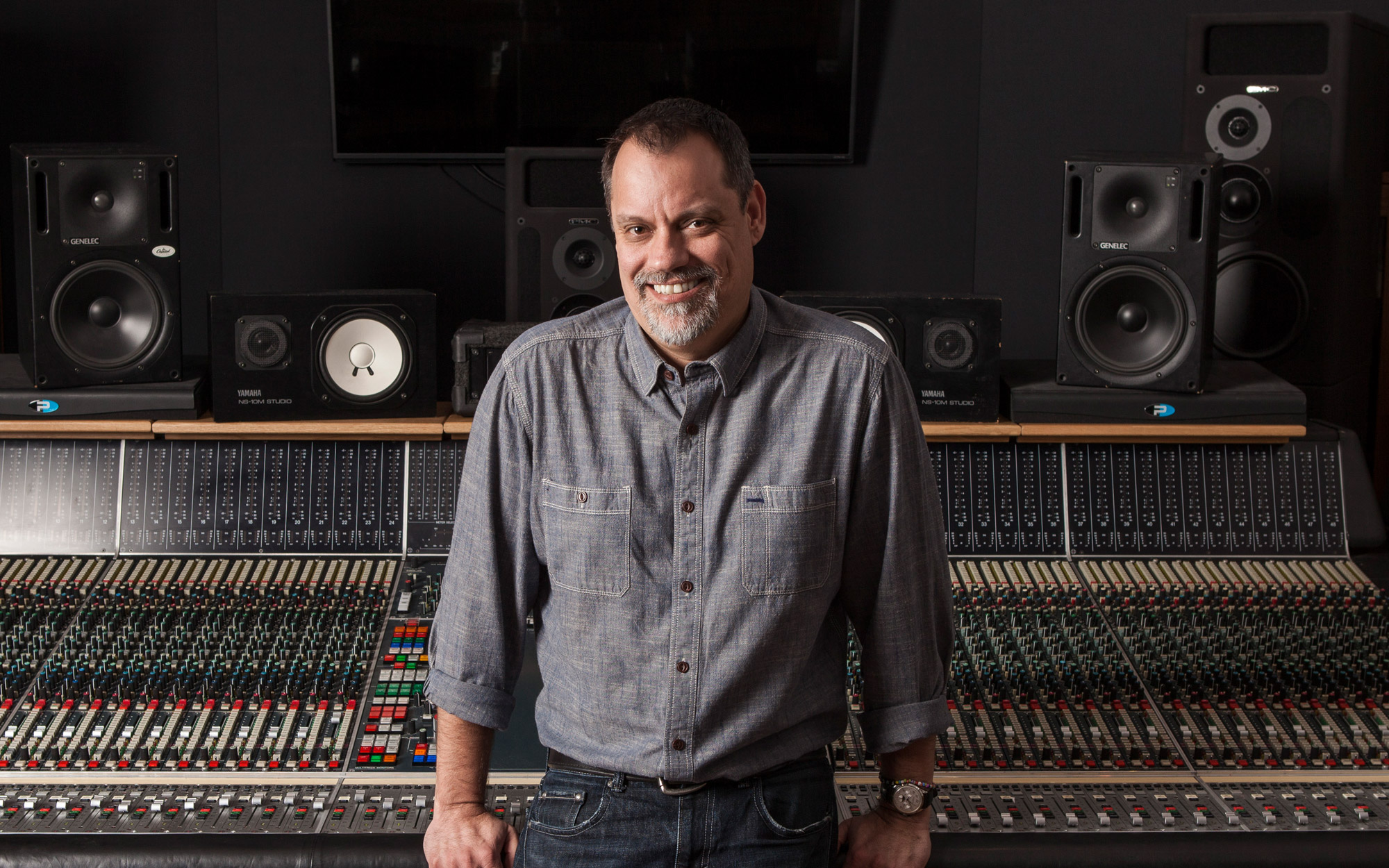
Steve Genewick is a greatly respected recording and mix engineer with extensive expertise in both live show and studio environments. He is an integral part of Capitol Studios in Los Angeles where he began as a member of the ‘set-up’ staff in 1994, frequently working with the late multiple Grammy award-winning engineer and producer, Al Schmitt, to whom he attributes much credit.
Steve recently won a statue at this year’s Grammy awards, and counts Elton John, Gladys Knight, Neil Young, Paul McCartney, Michael Bublé, Quincy Jones and many more among his impressive roster of clients. He was also one of the pioneers of Dolby Atmos music mixing, pioneering some novel techniques and working on the first released album to ever be remixed in Dolby Atmos.
Here, Steve talks about his journey, his personal tricks and techniques and how he uses LiquidSonics reverbs in his work…
At which point in your life did you realise you wanted to be involved in music?
Nobody was musical in my family. My mum and dad listened to the radio and CDs but I was always just interested in music and listening to stuff. I didn’t really play an instrument because growing up I played a lot of sports. I remember asking for guitar lessons when I was a kid and my parents were like, ‘well, we can do that, but then you’re going to have to give up something else’. I didn’t want to do that. I got my first guitar in high school and started playing around with that, I never really learned to play properly.
My friends were in bands, but I was never good enough to join. I liked hanging out with them and I had already caught the bug that I wanted to do something in music but I didn’t really know what. I liked the technical side of stuff. We were at a gig and I saw the sound guy, I helped him load in all the crap, he was the only guy doing anything, so that was interesting to me. I would stand back there with him and think ‘he looks like he’s in charge and having fun’, so I started looking into it. I was always fascinated; you’d see pictures of studios and big consoles and music videos of people and singers in studios, and I was like, ‘God, it looks kind of fun’.
I had no knowledge of how to get in or what to do. I found a recording school here in LA, it was called the Trebas Institute. I wasn’t going to college, so Mum and Dad said if that’s what you want to do, fine, we’ll do that. So, I enrolled in the school, kind of knowing nothing, which was good because I got to learn the basics – this is a compressor, this is how it works, here’s basic signal flow, stuff like that. Bobby Owsinski was actually my teacher. Then the guy who sat next to me in one of my classes was the night runner at a studio in LA called Cherokee, and he came in one day and told me he got fired because he did something stupid, and I was like, ‘Really? So they’re looking for somebody?’ He goes, ‘Yeah, dude, you should go get the job’.
So, I got up and walked out of class, got my resume and went down to the studio and I said, ‘I hear you need somebody’, and they were like, ‘yeah, we do need somebody, come back at four o’clock’. So, I became the night ride train for a week from 4pm to midnight, and then I became the night guy, midnight to 8am. I worked at Cherokee for three or four years, it was a five room place, it was fun, there was lots of stuff going on. I made it through to daytime runner and then assistant engineer. I got to engineer a few little projects and then that ran its course, they moved through people quickly. Then I was working with friends’ bands. I was going out on the road, doing short tours, doing a lot of live sound and making money and getting free beer.
I really liked doing live sound, I thought this is what I want to do. I ran into a friend of mine that I had worked with at Cherokee, a guy named Bill Smith, who’s still one of my best friends. He had left Cherokee and was working at Capitol and he said, ‘we had a guy quit today, they need somebody and you should come take the job.’ I was reluctant at first, I was having fun on the road, but he sat me down for an hour and explained Capitol to me – ‘this is a different kind of place, you’re going to see stuff you’ve never done’, and I think he mentioned they had just done a Sinatra record.
So, I showed up with my resume, and Michael Frondelli came back about two minutes later and he was like, ‘all right, when can you start?’. I came back that day at four o’clock, and that was my interview at Capitol.
What were you doing on the first day?
I was part of the setup staff; setting up the chairs, hanging the mics, that kind of stuff. We would get the setup from the engineers and then we would also take care of all the big setups and that was fun. It was stuff I’d never done – string dates and horn dates and orchestral and movie scores and TV shows. It was fun to get to learn that end of it, which I really liked. It was lots of high pressure and lots of people, I thrive off that kind of stuff, plus it was Capitol, so it was big gigs.
I think I’d been there about five days and I was setting up a huge two-room, 60 piece orchestra. It was the first time I met Al Schmitt, he was doing a Willie Nelson record with Jimmy Bowen producing and all these great musicians and I was like, ‘wow, okay, this is pretty cool’.
Do you think that was your tipping point, when it all changed?
Yeah, I think that’s when I went, ‘all right, this is it’. I always thought if I was going to do it, I wanted to do it big, I didn’t want to be doing demos for bands. That’s when I realised, these are the people I want to be around, these are the kinds of jobs I want to have, this is the place. The hard part about that is you also know it’s going to take a while because you don’t just walk in and do it, you have to learn the ropes and you have to get the clients and it takes years to do that kind of stuff, but I realised I was around the best people in the business, so I just soaked it all in. The other cool part about Capitol was that on these big sessions, they always needed two or three more people so I was getting called into sessions because we were locking two 24 tracks in a video machine and we’re running live mixes and all this stuff is going on that they need help with. Eventually I was doing enough session work where I wasn’t doing setup work anymore because everybody trusted me and I was getting good at it, so one day I wasn’t on the setup schedule anymore, I was on the other schedule.
A few years later, in one of the first big band sessions I did on my own, where I was the engineer, I can remember having a moment. It was quick, because I was in the middle of a big band session, sitting at the console, staring out, realising I was in the centre, and all the shit I’d been working for, I was like, ‘wow, this is it, I’m actually doing it, I’m in the chair’ and then it goes away, because you have to keep working.
I got to learn from the best in the business – Al Schmitt, Tommy LaPuma and Phil Ramone, Quincy Jones and David Foster, all these great producers. And when Al wasn’t working, I was with the other guys like the scoring mixers Sean Murphy and Frank Wolf. The film stuff was always interesting to me, that’s a whole other way of working and it was interesting to learn and to realise that there’s more to this than just making pop records.
Mixing was not the kind of big thing back then that everybody seems to make it out to be now. I think I heard you say once that great recordings mix themselves.
Oh, absolutely, 100%. Al and I used to say that we started mixing the second we got the gig because we were thinking about how we were going to set the room up or it was talking to the producer, the artist and figuring out what kind of record they wanted to make. That’s informing us about what we want to do. We’d then get a list of the players, and that’s informing us again. If it’s studio guys – what they like, what they don’t like, how are we going to set up? What room are we going to work in? That’s all mixing, kind of, because the idea is that we’re going to capture this thing, and we’re going to capture it right, and it’s going to sound like a record, take one.
So, even before pressing record, you’re trying to hear what the album will end up sounding like?
Exactly, yeah, and Al and I would talk about trying different things, sometimes there’s logistic things like the artist isn’t going to be there so we have somebody who’s going to sing a guide vocal which means we have to make sure that that’s totally isolated so that we can take it out, then we have to use that booth for that and this for this, and setting the room up and setting the mics. When the band started playing, it sounded like a record the second Al opened the speakers up.
Do you think some of that was informed by your days in live sound where you were sometimes having to get a mix without any sound check or anything like that?
Totally, yeah. Mixing on the meters, without turning the speakers on. I think I really learned it when I got to Capitol, watching that happen and, with an orchestra, if it’s a rhythm section, like a big band with strings, there’s a lot of moving parts. You’ve got a rhythm section, you’ve got a horn section, you’ve got a string section, you have to do that all at once, so making records is a team sport, it’s not one person.
So, bearing in mind that whole philosophy of you mixing the minute you start, before you even make the album or the track, how do you see mixing these days because a lot of records aren’t made that way anymore, they’re put together like jigsaw puzzles?
Exactly, and that’s why mixing is what it is today. It’s all just pieces in a box that you have to unwind. I enjoy mixing. When I get a big pop thing with a hundred tracks on it, it’s like, ‘oh God’. I think a lot of it is sifting through and figuring out what’s what and fixing problems. Most of the time, the recording is not great. People are recording in their houses and everybody’s got an inexpensive microphone that they say sounds exactly like a U47, and everybody’s got a cheap version of an 1176 that they don’t know how to use properly. When I get tracks like that, if it’s stuff I haven’t recorded myself, I spend 75% of my time figuring out what’s there and fixing the problems and 25% of the time actually mixing, actually doing the enjoyable creative part of it.
I’m not saying it’s wrong, it’s just the way it is, but nowadays you get vocals that are recorded with a plugin compressor so when they were recording, the dynamic range was under control and they were hearing everything great, but in the actual file the dynamics are outrageous, so I have to go through and fix all that. It’s a little bit different but it’s still fun.
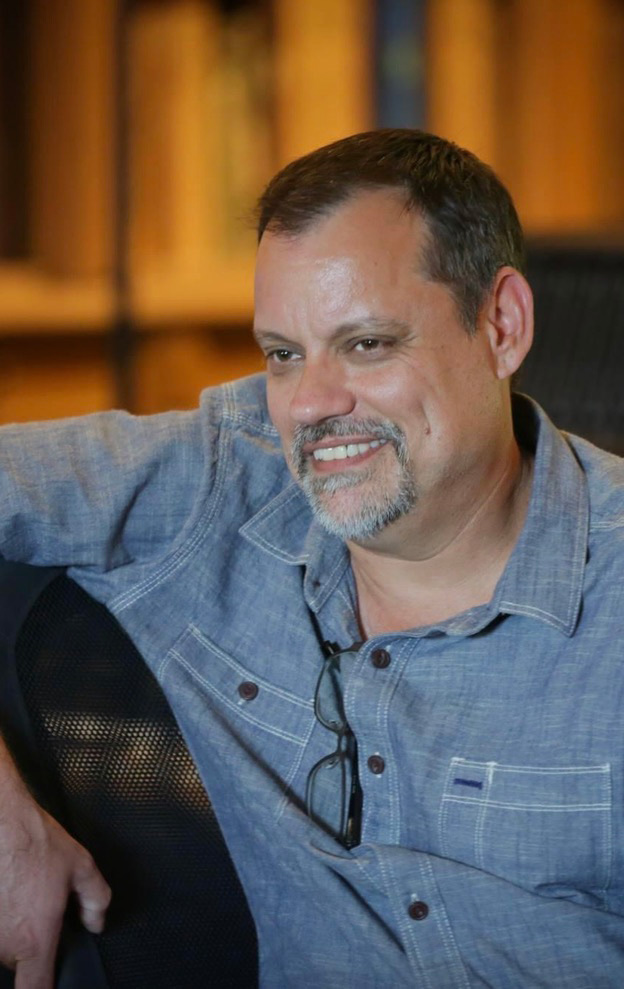
You were one of the early guys into Atmos mixing, was that a necessity as a mother of invention, or did you think, hey, I want to play around with this Atmos stuff and see what it’s about?
No, it was thrown in my lap. I got called into a meeting at Capitol (by this time I was a senior engineer), and they went, ‘so here’s the deal, we’re going to take studio C and we’re going to build a Dolby Atmos room and then you’re going to mix a record’. I was like, ‘why are we doing that? What are you talking about?’, to which they replied ‘well, they’re giving us a lot of money and they want us to mix this record, so we’re going to remodel the room. It should take about a month. We’ll teach you how to use the system and then we’re going to give you this REM record Automatic For The People and the band will be here in two weeks. Figure it out. Have fun’. It was the first record ever to be mixed in Atmos for release.
But in some ways, the technology still wasn’t settled. The philosophy still wasn’t settled, was it? Did you feel like a pioneer or did you feel like, ‘hey, what the hell have I been handed?
Yeah, it had never been done in music. I had been through the 5.1 thing so mixing and surround was not that foreign to me and I’d worked on enough movie scores and stuff like that so having speakers behind me wasn’t a surprise, let’s put it that way.
Learning to use the system and learning what the objects did and why they did it and all that kind of stuff, was a bit of a thing. Then I was also kind of mixing blind because I had no idea what I was mixing for or why, and people would say ‘well, how are people gonna listen to this?’ and I had no idea. This is the only place I can listen to this. I have one room, and I don’t know if this is good or bad, or I don’t know why I’m doing this. Now, in hindsight, there were deals in place with the big companies, but I didn’t know that. They would just be like, ‘here, mix this song’.
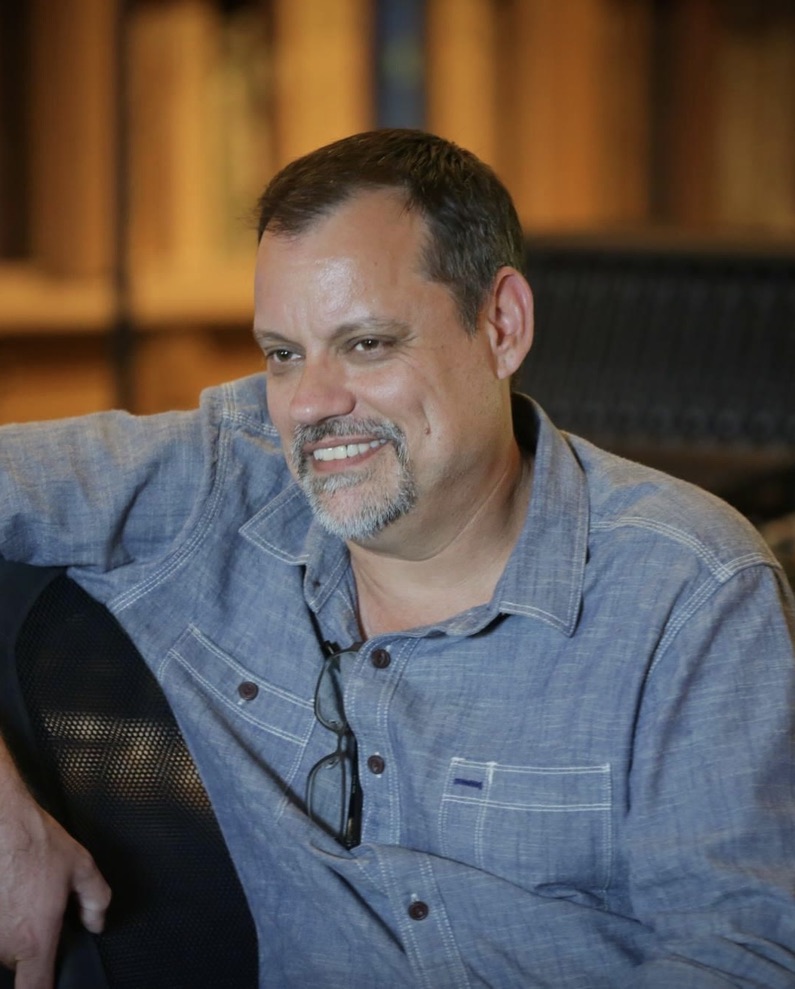
Coming to the technical aspects, in the early days we had no Atmos reverbs…
I had to figure out how to do it so I made them up myself!
You created several busses, didn’t you?
I called them my zones, but now we call them an object bed, where I have static objects in places and I can steer stuff into it. Now it’s part of Pro Tools, you just click on the little thing that says object bed and it shows up. But once I came up with that, I was like, ‘oh, well I can put my reverbs in here too’.
So, what I started to do was take a plate plugin that I liked, that’s stereo, because it only exists as a stereo plugin. Then I would think ‘well, I need four of them – I need one in the front and one in the front sides here and one of the backsides and one in the back. Oh no, now I need three up there’, I kind of put them where the speakers were. So, I had one send that would send to all (I think it’s eight or nine) instantiations of this to make one reverb.
Then I had a big, huge mono reverb, then I figured out, obviously with pre-delays, I can decorrelate this.
How did you manage fold down doing that?
Well, two things. I didn’t care about fold down (at the time) because it was Atmos, they told us about binaural but I didn’t think about binaural until two or three years later, we never even considered it. We never listened to it because it wasn’t a thing. It was, ‘oh yeah, there’s a headphone thing, but that’s coming. We don’t worry about that’.
So I figured out this pre-delay scheme to decorrelate these reverbs so that I had a reverb that would fold down. You do kind of fold down in Atmos because if you go to a smaller system, the renderer plays it back on a smaller system, but by using the objects it kept it where it was supposed to be in the room, even if there wasn’t a speaker there, so it ended up working out really nicely.
The nice part was, especially doing catalogue stuff, I could use all the effects that I needed that I already had. I could use an AMS. I could use a four ADL. I could use a plate. I could use a chamber. I wasn’t struggling to find the right reverb, I already knew what they were. I basically just took what I was doing in stereo and expanded it out. It made my Atmos template 150 tracks before I put anything in it, but because I had all these bussing schemes, we were literally making it up as we went.
It was me and two other guys at Capitol who were mixing and we were trying to come up with techniques to make this thing that was designed to make a movie, make a record, and to give us stuff that we were familiar with so, again, I’m not going out and looking for new reverbs. I go get the 250, that’s what I want, and I pull it up and I put on the settings, because I know what it sounds like, and off we go. We’re still mixing, we’re not trying to reinvent reverbs anymore, but it worked really well. To be honest with you, I still use it almost exclusively, even if I’m using newer reverbs, I found that putting it into my scheme gives me a lot of control over it that I don’t have in other places.
Are you still using the LiquidSonics reverbs in that scheme rather than using them in their Atmos mode?
With LiquidSonics I use both because even before Atmos I was using Seventh Heaven, because it is based on the Bricasti that we had that Al loved so that’s always been part of my mixing. I can’t remember a record where that hasn’t been on in a long time.
Then Cinematic Rooms came out and suddenly I could expand it into what I needed. There’s times where I’ll use an immersive reverb, a 9.1.6 or something, and there’s times where I’ll use my version of it.
I tend to use Cinematic Rooms for big lush reverbs, big string sections and stuff like that and then the smaller rooms tend to be more in my scheme again because I can control it; it’s really easy to grab a fader and pull it down 3 dBs or to mute. If I’m mixing in Atmos and I have a vocal that’s got reverb embedded in it, I may add a little bit of reverb, but just to the sides and the rears, because I already have reverb in the front where the vocal is so I’m just going to add a little bit more to the backs. A lot of it is just workflow, how to work quickly.
Like I said, for the bigger stuff when I’m working on movies and things like that, I tend to use more of the multi-channel stuff.
And was it nice to eventually get a Bricasti that was running in Atmos when we eventually made Seventh Heaven in Atmos?
Yeah. Great. I still love that. That Clear Hall setting is the one Al used all the time. The other thing is, I got used to hearing all this stuff that he did so it’s very familiar to me, so, a lot of that stuff I still use just because it sounds right.

Because you are such a sort of ‘meat and potatoes’ recording engineer that gets it right almost before you hit the mix, do you find yourself using things like the crossfeed features in Cinematic Rooms or are you simply getting a preset up and just getting a great sound?
I’m a preset guy. I just kind of flip through presets until I find the one I want. I might adjust a little, delay times and pre-delays and stuff like that.
Is there always pre-delay across your scheme?
So, in my scheme, they’re actually tempo-based and they get longer as you go back in the room. So, in the scheme itself, there’s no pre-delay in the fronts, but as you move back, we’re talking very short 10, 15 milliseconds back, if I want pre-delay, I can add it in the actual plugin. So, like on Seventh Heaven’s Clear Hall that I use mostly on vocals, there’s a pre-delay anywhere between 80 and 100 milliseconds, and that’s a musical pre-delay. I want this up, I want the separation, so I do use pre-delays quite a bit. Almost every reverb I have has one, but that’s not part of my reverb scheme, it’s on top of that.
One thing I’ll do is, on my Clear Hall vocal reverb, the pre-delay isn’t in Seventh Heaven, I have a delay before it that I add feedback to. So, it’s not just a ‘bump bump’ in my pre-delay, there’s feedback in the pre-delay. It’s very subtle, but there’s a couple of repeats going into the reverb. I don’t know where I came upon that, I probably pulled up a preset that had it in there and went, ‘oh, that’s cool’, and I kept it.
Which presets are you using most frequently in Cinematic Rooms?
I have two that I use all the time, I use Dark and Large Chamber, and I use Medium and Stage in the Halls.
And presets in Seventh Heaven?
Well, Clear Hall is on everything, that’s my main one, and then the other one I use all the time is Gold Hall.
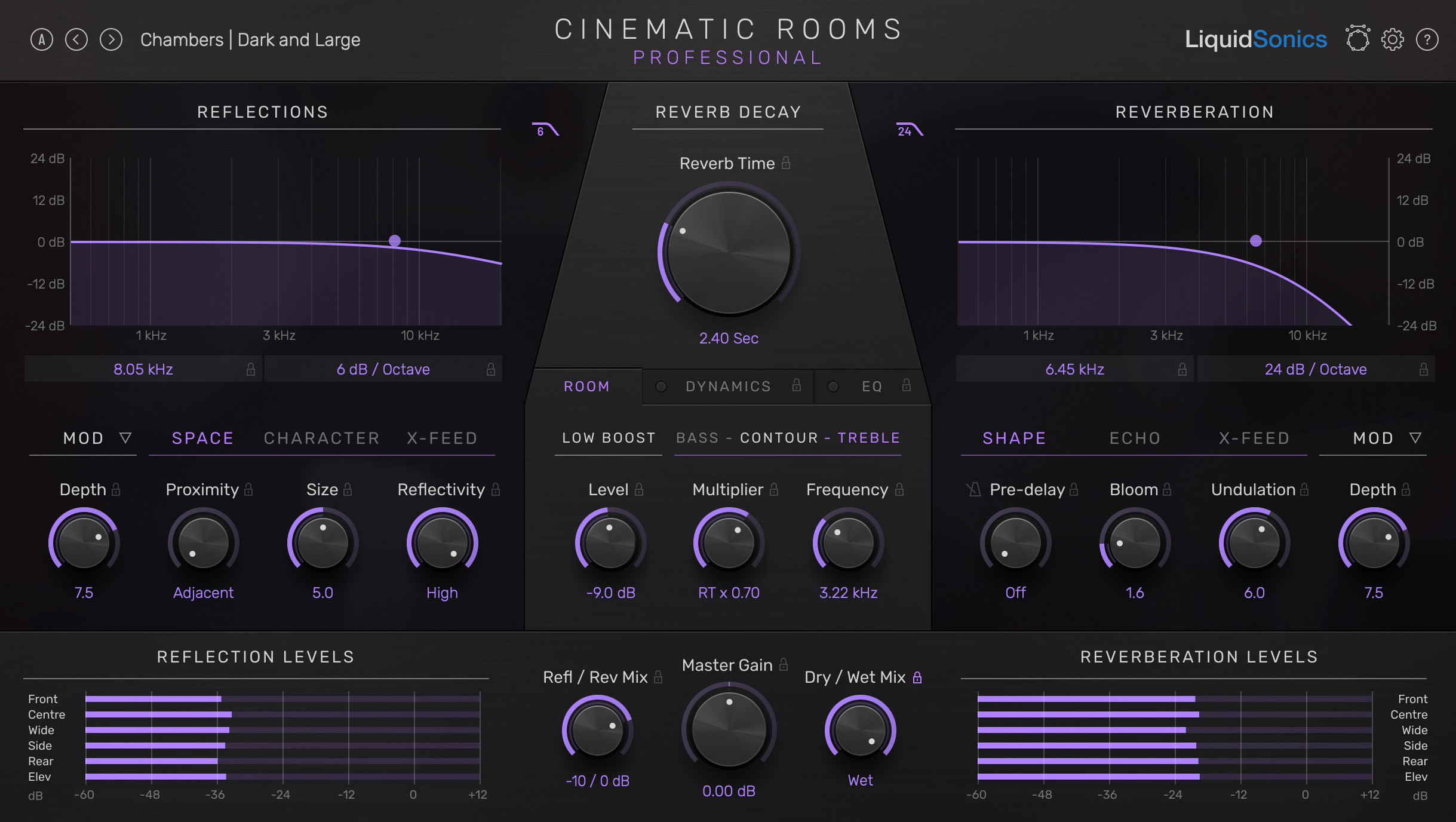
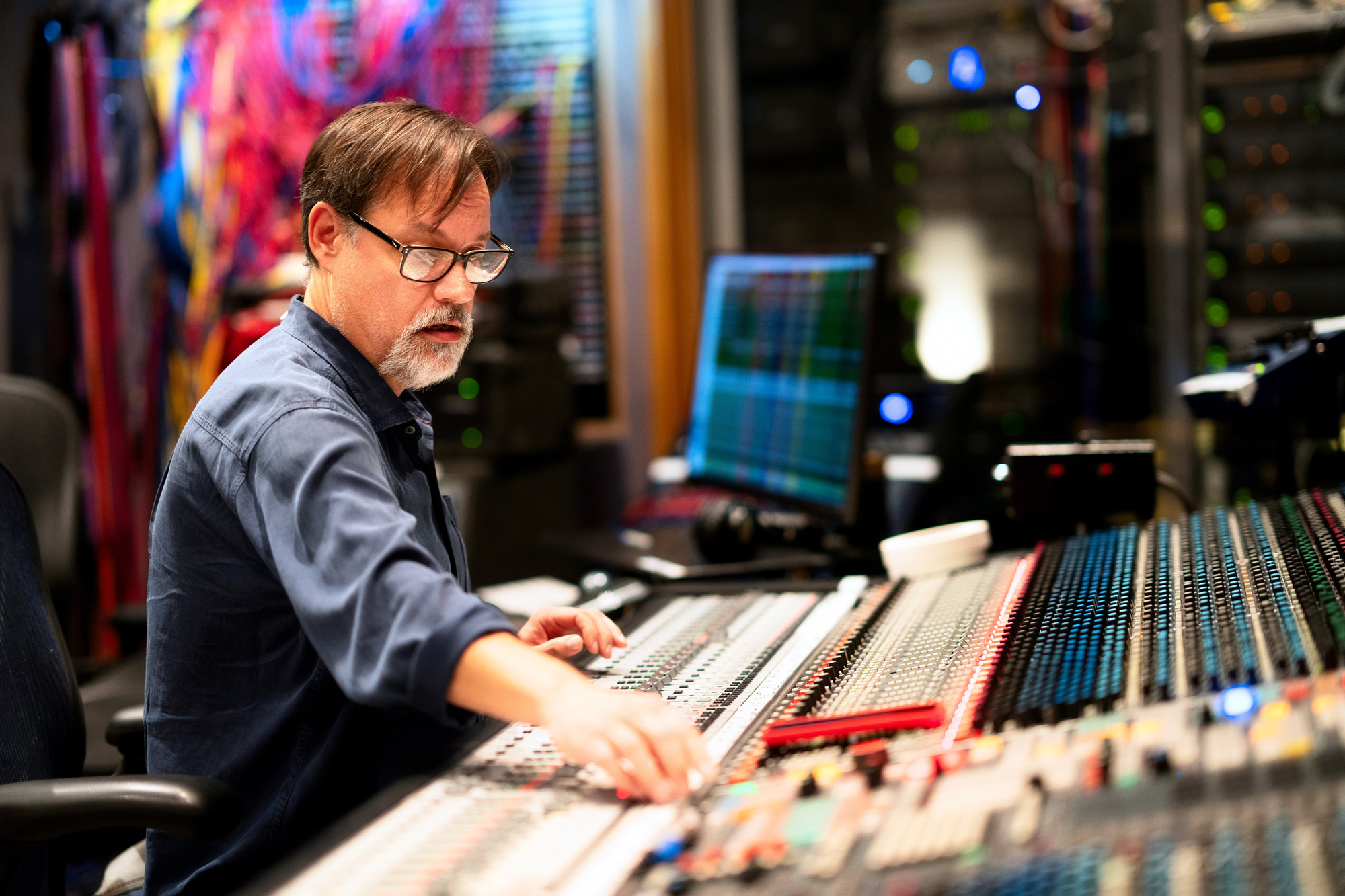
Finally, to wrap up, you received a Grammy recently didn’t you?
Yeah, I got a Grammy for the Best Large Jazz Ensemble category for the Count Basie Orchestra album (Basie Swings The Blues). I recorded the whole thing in a day and a half, then we had guest artists over the next six months, some of them I did and some of them we sent out and then I mixed it all here at my place, and there’s an Atmos mix of it too, it was fun.
It is my first statue, I’ve had certificates before because in the album categories, as an engineer, you must have engineered more than 51% of the record. So, for instance, the year before, Michael Bublé’s record won a Grammy for Traditional Pop Vocal Album but I had only recorded one song and did strings and horns on two or three others, so I got a certificate for that, not a Grammy. I got paid though, that was nice. I think getting paid is always harder.
Steve’s path from a sports enthusiast with a guitar to a Grammy-winning recording engineer underscores the significance of passion, perseverance, and openness to innovation. His ongoing commitment to exploring new horizons in music production is undeniable. It should come as no surprise given the mentors he worked alongside, that Steve Genewick’s influence on the industry is considerable and leaves an indelible mark.
